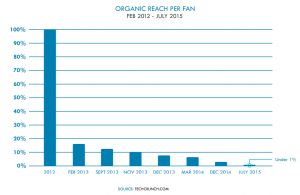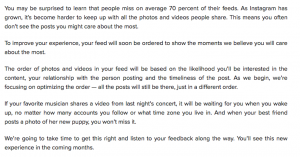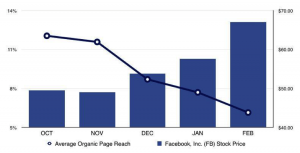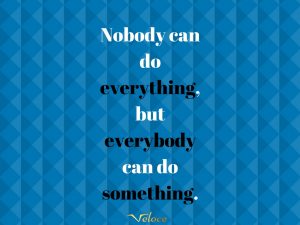How to Market Your Brand in the Saturated Landscape of Social Media
When using social media for marketing, you’re essentially doing one thing: fighting to get people’s attention.
This is especially true for marketers – no matter where you’re spending your marketing efforts. If you’re buying ad space in television, you’re essentially buying people’s attention for a few seconds, if you’re paying for an ad in the newspaper, you’re buying the attention of people for a few seconds there, too!
The catch, however, is that in marketing, the attention is not the only thing that matters. In order to generate great results in marketing, you need to attract the right attention – the attention of your target audience.
In theory, social media is just like all other marketing sources when it comes to getting people’s attention, but this is only true if you’re paying for social media ads.
And when you’re paying for social media ads, you get what you get and you get what you pay for.
Sure, as more people realize just how effective social media advertising is, for example, the use of Facebook ads, the prices for buying attention will be higher, because the platform only have a limited number of users, and either, they have to shove more ads down their throats, risking to harming the platform, or, take more money for the same ad space.
It’s all a simple matter of supply and demand.

But in this article, we’re not going to focus on paid advertising on social media. After all, it is the organic reach of the different social media platforms that are getting saturated the most.
Content saturation is a real threat for marketers because they live off of people’s attention. Because as it gets more difficult to get people’s attention, they have to tweak and improve their strategy to be able to generate the same results from the same social media efforts as earlier.
The content noise is not only taking place on social media but more so everywhere where content is distributed. Think about it: people have a limited amount of attention and time, and if more and more content is being produced, it would mean that they would need to spend more time to see it all. While people do spend more time on social media, there is far more content being created than what can be consumed.
In this article, we’re digging into a subject that isn’t spoken about too often. We’re digging into the world of social media, how to market yourself in the saturated landscape of social media, and how you can beat your competitors for the attention of your audience.
What’s the deal about social media being saturated?
Saturation is here and it is happening.
I’ve already talked about content saturation on social media briefly, but to refresh our minds, I’ll talk about what it is and then dig into what it means in practice.
Content saturation means that there is more content being produced than what can be consumed.
Social media saturation means the exact same thing, just that it is taking place on social media.
The reason why saturation is happening is simple: more content is being produced. In fact, 76% of all B2C and 88% of all B2B marketers have integrated content marketing into their overall marketing strategy.
If you’re new to content marketing, Wikipedia explains it this way:
The same survey also finds that “Producing Engaging Content” is the most challenging hurdle that both B2C and B2B marketers singled out.
To realize just how much content being produced, let’s take a look at some statistics. Only then can we understand just how tough the competition is. And the key to solving a problem is, as you know, being aware of that it exists.
- 656 million tweets per day
- More than 4 million hours of content uploaded to Youtube every day
- 90% of the data on the internet has been created since 2016, according to an IBM Marketing Cloud study.
- Since 2013, the number of Facebook Posts shared each minute has increased 22%, from 2.5 Million to 3 million posts per minute in 2016. This number has increased more than 300 percent, from around 650,000 posts per minute in 2011!
- 90% of world’s data generated over last two years
- Every two days now we create as much information as we did from the dawn of civilization up until 2003
All of these statistics are completely mindblowing, but let’s look at the reasons why the social media landscape is getting saturated so we can find solutions.
Why social media is getting more saturated
The answer is quite simple, really, and I touched briefly on it earlier: when more content is being created and distributed than what can be consumed, that’s when content saturation will be born.
And considering the pace that social media has grown in, and the pace that content is being created in, it’s not very surprising that it is happening, and that is it happening at an incredible speed. You should also remember that where people’s attention is, brands and marketers will be. And for organic social media marketing, the way to reach your audience is by creating content!
Obviously, the fact that more content that people are able to consume isn’t the only reason why social media has become saturated. In one way, it’s far more complex than that.
The things that have had the biggest impact on the decreasing engagement and reach on social media is not just that people don’t have time to look at it, but instead, it is because most social media platforms have incorporated some kind of algorithm in their platform that decides what content you are going to see in your feed.
Back in the days, when very little content was being shared on social media (little being relative), there was no need for algorithms, because you followed a few people, and you had the time to look at the few posts that showed up in your feed.
But as social media grew, social media platforms got older and accumulated more users, more content was being shared on their platform. The increasing content ultimately means that in order to give its users a good experience, the platforms need to introduce some sort of algorithm that sorts out the irrelevant stuff and only presents the content that the algorithm believes you’ll like.
Facebook is probably the social platform where the organic reach has declined the most. And considering that it is the world’s largest social media platform, is it that strange?

These are the two reasons, according to Facebook that the organic reach is decreasing:
“The first reason involves a simple fact: More and more content is being created and shared every day. You’ve probably felt this change yourself. Just a few years ago, sharing important moments and experiences, articles you’ve read, and photos and videos of your loved ones was a relatively labor-intensive process. Today, thanks to devices like smartphones, many people can share this content with just a few swipes of the finger or taps of a button.”
There is now far more content being made than there is time to absorb it.”

How to battle social media saturation
Share high-quality content
This is the single best and most effective solution to cutting through the noise on social media.
I cannot emphasize enough how important having quality content is, because it is the foundation to being able to cut through the noise on social media and get more reach. And because we know the goals of the algorithms, we know what we can do to make it work in our favor. Algorithms have a few goals, and those goals are to present high-quality, attention-grabbing content that is relevant to the users (the people who are following you), and that they think is interesting.
Quality can be measured from several aspects. First off, we’re no longer living in the time when the best cameras at an affordable price are Nokia phones that take photos that look like they were taken by a potato. In fact, you can actually take quite high-quality images with the phone you have in your pocket.
In other words, blurry and low-quality images just won’t cut it if you want to cut through the noise. Low-quality content is the type of content that the algorithm favors the least, and the reason is simple: it is the type of content that people like the least!
Remember that the algorithm only favors the type of content that people want to see, and sorts out the content they don’t want to see. And it does this with information from how people interact with different kinds of content.
If you want to batter social media saturation, you need to step up your content creation, and never satisfy with “it’s fine” when it comes to your content. Only satisfy with the best, most flawless content.
Related: https://www.veloceinternational.com/general-social-media/implement-appealing-visual-content-on-social-media-with-these-smart-tactics/
There’s no going around this because it is the foundation of social media success! If you cannot create high-quality content, then you shouldn’t be on social media. It’s all about creating content that holds an even higher quality than all of the businesses and pages you are competing with.
Understand what content your audience likes
The second factor that affects how the algorithm ranks your content is relevancy. Apart from sharing high-quality content, it needs to be relevant to your audience, too. For example, you might have hired a professional photographer to photograph a cat, which resulted in top-notch quality photos, but if you post it on a page that consists of people who are passionate about dogs, you can guess that the post won’t generate very good results.
Reason?
It isn’t relevant to your followers.
Since the algorithm’s goal is to present relevant content to your followers, it will filter away your post if it finds that they aren’t relevant to your audience.
THerefor, to beat the algorithm, or more so, give it what it wants, you need to understand what your audience wants. Remember: with an algorithm or not, the key to cutting through the noise is sharing content that your audience will find interesting, and if you can, sharing content which is interesting than any of your competitors’.
The first step to sharing more relevant content is to look at the content that your audience has liked a lot in the past. If you’re using a social media platform that has built-in analytics, you can easily go to the analytics and take a look at the posts that you’ve shared that have generated the highest engagement and the most amount of reach.
Now, take a look at your most popular posts and see if they have something in common. Is it posts with a special motive that gets the highest engagement? Is it photos that have been edited in a special way that seems to be performing the best=
Try to identify the differences and the similarities between the top-performing posts and then create more content that is similar to that. By doing so, you significantly increase your chances of creating content that your audience will actually like. In fact, you’re not just significantly increasing your chances but you’re using a surefire method of making your post perform better.
After all, the best way to predict the future is to look at the past.
Understand what drives your audience
The most important factor of how well your content performs on social media -no matter if it is paid or organic exposure, is your audience.
The better you understand your audience, the better results you’ll be able to generate.
This does not only go for the content that “receives the highest engagement” because the truth is that there are far more aspects than just the engagement.
Sure, you might have great content that fills all the criteria above, but the thing is, you only have a few seconds to grasp your audience’s attention, and if you can’t do that, they’ll continue scrolling.
In order to impact your audience on a deeper level than just getting them to press the like button, you need to use powerful storytelling that has a long-lasting impact on them.
Sure, likes are nice, but I am guessing you have another objective with your social media efforts than to just receive a few likes?
Storytelling is tremendously powerful, but in order to be able to tell captivating stories, you need to know a bit about your audience first.
The first step is to ask yourself (or find out) what their passions and interests are. By knowing this, you can create content that is more relevant to them but also tells stories that better resonate with them and that impacts them to the level that they buy from you (or does what you want them to do).
Next, you need to identify their pain points. Because it is only when you know people’s pain points that you can persuade people to buy from you. To identify this, ask yourself what pain points your audience, as well as what problem you are able to help them solve.
By doing this, you can provide your audience “more” value, at least in the eyes of your audience, by actually proving and convincing them that your content gives them something. I’ll dig more into providing value with your content in the next point, so hold on tight.
The last questions you want to ask is how your target audience consume their content. are they mainly mobile or desktop users? Do they get their content from industry influencers or do they turn to brands for content? or do they turn somewhere else?
Provide value
Apart from creating high-quality content and making it relevant to your target audience, I’d dare to say that providing value with the content you share is the most important ingredient to cutting through the noise and sharing content that your audience looks forward to seeing, and then comes back for more.
The reason?
When people feel like they’re getting something, they are far more likely to come back. it can be many things apart from a social media post, in fact, it is a practice that is used in business and marketing because it plays on the human psychology, called reciprocity. This means that in general when humans get something from someone, we feel the urge to repay the favor. So if you are providing your audience with value, time and time over, eventually, you will have guilted them into buying from you or doing anything else from you.
Now, I got a bit ahead of myself, but the first step is obviously to just get your audience’s attention, and the truth is that when you are providing value, you are much more likely to get it.
Think about it as a relationship.
A give-take relationship will be far more successful than a relationship where only one part takes and takes and never gives, right?
The more value you give, the more attractive you’ll become to your audience, and the more likely you are to see you in a positive light and as a source that they’re actually getting something from.
The result?
They’ll go to you more often for our content.
What’s more, when it comes to the social media algorithms that decide what content people are going to see in the feed, a ranking factor they use is “searches for profiles”. This means that by creating content that your audience love and feel like they’re getting value from, you can get them to come to your page themselves, and then, as a result, get more of your content in their feed.
Identify your competition
An important part of breaking through the social media noise is understanding where the noise is coming from, and what weapon you need to use to cut through it. You now know what makes content perform well on social media, and what content social media algorithms favor, so now, it’s time to identify the people who are sharing the content that is stealing the attention of your target audience, to ultimately understand what you can do to steal it back.
You should begin by identifying your main competitors. After all, your competitors are your competitors for one reason: you compete with them for the same target audience. And the only way to win over your competitors is to always one-up them, and always be better than them. If they share a post, your post should be even better. If they create a product, yours should be even better.
Start by looking at the content they share, how many followers they have, and what engagement rate they have. Compare their engagement rate with yours to try and understand if they really are sharing better content than you, or if it’s just that they have more followers than you.
Of course, you need to have in mind that the content they share isn’t the only thing that affects how a post performs. But if you notice that some of their posts are performing exceptionally well, you should learn from that and try to replicate their success – only that you’re going to do it better.
When you’ve gathered information about your target audience, who they follow, and what content they share, you can begin fine-tuning your content strategy, as well as building your resources and start planning for how you’re going to create the content for your content strategy
Optimize your social media posts
I’ve talked briefly about what you can do to your social media posts to make them more appealing, but due to the fact that it is the content you share that has the greatest importance of how well you’re going to perform, and if you’re going to be able to cut through the noise, I cannot talk about it enough.
There are so many things you need to think about when crafting the perfect social media post, and the more you optimize the post, the better it’ll perform!
Start with the basic of sharing photos in the right format, having a clear and compelling text with an appealing call-to-action. If you’re using a social media platform where hashtags are effective, then use those. When posting, ask yourself: ”how does this bring value to my followers?”. If the answer is that it doesn’t, then don’t post it.
Note that value can be many things. It can be giving your audience a good laugh, information, news, entertainment, or straight up value in the form of a giveaway or coupons. Take what you’ve learned from your top performing posts and improvement that into your content strategy today to be able to replicate the things that make your posts successful.
If you’re writing, keep it short and concise, and keep the most interesting parts at the very top. You only have a few seconds of your audience’s attention, so make the most out of it.
Don’t share page long captions or texts, because the truth is that you’ll only scare your audience away, and when the algorithm notice people shy away from your content, they’ll do you a disservice of ranking your content farther down their feed.
To keep people interested and engaged, include exclusivity, urgency, and benefits in your posts
The more hype you build up around your posts, and the more exclusive you make your posts feel, the more engaged your audience will be, and the bigger the chances that they’ll engage with your posts – and find them interesting.
Don’t be promotive
If there’s something people hate on social media, it is promotional content. People aren’t on social media because they can’t wait to have ads shoved down their throats. THey’re using social media to stay connected with their friends, get inspired, get entertained, get information, tips, and knowledge.
Not only do people dislike ads on social media, it is a surefire way to scare them away from you.
People are on social media because they want the things above, and if you give that to them, you give them value – you give them something they want. Thus becoming a resource of value to them.
Yes, I understand that you as a brand want to use social media to promote yourself, and I was just like that when I first started out with social media. The reason?
I thought that was the best way to generate best marketing results.
The truth?
It wasn’t.
Want to know the best part?
The best part is that you can generate amazing marketing results with social media, but instead of shoving ads down your followers’ throats, you can provide them value with the principle I talked about earlier: social reciprocity.
Instead of promoting and scaring your audience away, you give them so much value that you’ll guilt them into buying from you.
In other words, you’re actually generating better marketing results by promoting less.
Crazy, right?
Create posts that impact your followers’ emotions
Humans are emotional creatures.
If you want to grab their attention so they engage with you, what do you do?
You craft post that impact them deeply and leaves a long-lasting impression on them.
The good news?
Few of your competitors are crafting posts that impact their audience on a deeper level, which means that there is lots of room for you to sneak in and steal the attention that your target audience is currently putting on your competitors.
Happiness is the feeling that has shown to have the biggest effect on humans, at least when it comes to impacting them as a brand on social media because it makes your audience associate your brand with a positive feeling an memory. What’s more, it allows them to better resonate with you as a brand.
But that is not to say that you cannot play on other emotions with your social media posts to leave a big impact on your audience.
As long as you do it seamlessly and in a way that resonates with your target audience, as well as avoiding stepping on any toes, you’ll be fine.
Of course, succeeding in this demands you to know your target audience very well.
Don’t go after the large market
What is saturated is the mass market. The niches in the small markets are seldom saturated, because the more that can be made, the higher the competition will be- But the thing is that you can reach great success by building a small yet highly engaged audience as opposed to building a large and unengaged audience. Or, if you are able to, you can go after several specific and small spaces at once.
The mass market is already saturated, and this means the competition is tough. Instead, try to identify small areas closely related to your niche but that aren’t yet ”discovered” and infested by your competitors. Then, use content that speaks to a specific audience and not to everyone. Sure, you won’t reach as much, but as mentioned earlier, a smaller engaged audience is better than a large unengaged audience.
On social media, engagement is everything. Followers aren’t.
Use influencer marketing
Everyone on social media is relying on the organic reach. Except for a few business that solely focuses on paid social advertising. And although the social media landscape is tough and saturated, there are people who have succeeded in building a large audience of engaged followers
I am obviously talking about influencers
In case you are unfamiliar with influencer marketing (I’d be very surprised) I’ll explain it briefly:
An influencer, in a social media context, is a person who has built a large audience of engaged followers who look up to the individual for go to them for inspiration or advice. The influencer is an influence because they influence other people’s advice.
Influencer Marketing is, as the name suggests, marketing with influencers. This means that you get the trusted individuals on social media, the influencers, to talk about your product or brand and recommend it to their audience. Sure, you’re paying to cut through the noise on social media, because most influencers want some sort of payment in exchange for marketing posts. Others, however, will satisfy with just a product sample.
But the thing is, done right, influencer marketing has a tremendous power, and best of all, the influencers have an immense trust, which means that you’ll not only cut through the noise of the saturated social media landscape and reach more people, but you’re also going to be able to drive great marketing results.
In fact:
- 49 percent of consumers rely on influencer recommendations.
- 49 percent of consumers rely on influencer recommendations.
- Influencer marketing campaigns generate $6.5 in earned media value for every $1.00 invested.
- 13 percent of brands generate $20 in revenue for every dollar invested in influencer marketing.
The truth is that even with their specific targeting when it comes to social media ads, on-platform such awn Facebook ads or Twitter ads, you’ll have a hard time reaching these results.
Why?
Because influencers have an audience that trust and follow their words, Ads, on the other hand, are trusted by no-one.
Gaining traction on social media is though, and getting exposure in the saturated landscape takes time and lots of effort. That’s why piggybacking off of influencers is both an effective and affordable alternative to skyrocketing your results.
Use social media ads
This is the most obvious solution to the issue of decreasing organic reach.
If you don’t have a tremendously powerful content strategy, or even if you have, you cannot always rely on the organic reach, because the truth is that ads on social allow you to reach a ton of people at a quite low cost.
Social media ads allow you to target your ads based on a variety of different criteria, which means that you’ll only reach the people who truly matter.
As the social media landscape gets more and more saturated, the organic reach will continue to reach all-time low levels, and therefore, solely relying on organic reach on social media is a risky move.
Because what will end up happening eventually is that you’ve spent a ton of time and effort and money into building your audience, but then, you aren’t even able to reach them with your post.
And to rant for a second, what upsets me a bit is that businesses and people have spent millions and millions of dollars on building their page on platforms like Facebook, in the hopes that they are able to reach their audience over and over again, but as the organic reach is decreasing, these people are reaching virtually anyone, a tiny fraction of their audience.
In other words, they’ve wasted a ton of money – except for the fact that having lots of page likes can make you look more authoritative.
Take a look at how Neil Patel regrets that he bought his Facebook followers:
Some people accuse platforms like Facebook to decrease the organic reach to force businesses to pay for advertising, but I am not going to discuss that today. I leave that up to you to decide.
But there is no doubt that there is a correlation between Facebook’s stock price (as the money people spend on advertising increase) and the decrease of organic reach. You can’t deny that because it’s clear as ice.

Focus on the right platforms
It’s not only the content you share that is important for cutting through the noise of social media. Sure, it is undoubtedly the content that is the most important part, however, if you share content that is very specific to your target audience (which you should) you won’t generate very good results unless your target audience is to be found on the platform you’re using.
Context is just as important as content.
Or, as Gary Vaynerchuk put it:
“Content is king, but context is god”
In other words, you need to think about what social media platforms you’re using.
First off, you need to always stay up-to-date with the latest popular social media platforms, because you don’t want to be last to the party once it explodes in popularity.
But most importantly, is that you know where your target audience is to be found and where they spend their time.
First off, identify your target audience if you haven’t already. Secondly, you want to look at the demographics of the platforms you’re using, or plan on using.
For example, if your target audience is solely men, platforms like Pinterest, that has almost only female users might not be a good choice for you. And since the organic reach is already tough as it is, you don’t want to struggle with reach and engagement as a result of the fact that there are few people from your target audience that are using the platform you’re investing time and effort into.
Identify new emerging platforms
This one is my favorite because it means predicting the future and being ahead of everyone else.
What you’re going to do is constantly check for emerging new social media platforms and if they’re worth trying out. If you believe they have potential, then start using them and building your presence!
The best part about this is that social media platforms become saturated as the number of users increases. Because when the number of users increases, it also means that the amount of content being shared is skyrocketing through the roof, which, in turn, leads to lower engagement, and often also, as the history has shown, the introduction of a social media algorithm that sorts out the irrelevant and low-quality content.
In other words, new emerging platforms aren’t yet saturated, which means that you can establish a strong presence on it due to the low competition and the organic reach. The best part about this is that once people start realizing that it is an awesome platform, and more and more people start using it, you’re one of the top players, which means you’ll automatically attract more people.
Awesome, right?
The challenge isn’t always to increase your engagement on the platform you’re using right now, but it can be identifying potential emerging platforms and taking advantage of the low competition to establish your brand.
Ask your audience to share
While the organic reach is decreasing on social media, getting your audience to work for you, and spread your message for you, is a great way to boost your reach and cut through the noise.
Remember that nobody can do everything, but everybody can do something.

And if you can get everyone in your audience to do something, you will have gotten them to do quite a lot for you.
Not only are social shares extremely powerful for cutting through the social media noise because they allow you to reach more people by simply asking your audience to share it (or in some other way convince them to do so), they are also effective because it is a ranking factor of algorithms. In other words, when someone shares your post, the algorithm takes this as a sign that they like it, and therefore, it will show more posts from that account in your feed in the future.
Engage and build relationships with people
When you engage with people on social media, the algorithms will take this as a sign that your account is relevant to the user. This will ultimately lead to an improved position in their feed every time you share a post. This means that you’ll push your competitors down while crawling yourself up.
In one way, engaging with your audience is a subtle way to fight with your audience.
Want to know the best part?
Very few actually take the time to listen and engage with their audience and build strong relationships with their audience, and for you, that is a good thing.
Not only does engaging with your audience indicate the algorithms that your account and content are relevant to them, but you’ll also make your audience engaged and loyal to your brand.
That way, people might come on own initiative to your page, but there’s also a great chance that they’ll become brand advocates for your brand, loyal supporters that go around telling everyone how awesome you are, something that is extremely valuable for brands.
Working to build strong relationships with your audience should be far high up on your priority list.
Not only are strong relationships beneficial in getting the algorithms to present content far up in their feed, or making them loyal advocates, but building relationships with your audience also means that you increase their trust in you.
And when they trust you, they’re far more likely to buy from you.
Think about it:
Would you buy from a brand that you don’t trust?
Since building relationships are so tremendously important, here are some resources for how you can build them.
Amplify what works
If you’re going to run social media ads, you shouldn’t just share a post and click ”boost”.
There are two main ways you can run an ad on social media. First, you can set up a completely individual ad post and then set it as an ad. The other method is to share a completely regular post and then boost it to reach a larger audience.
No matter which of these methods, you shouldn’t just aim in the dark and guess which posts will generate great results.
Obviously, want to get the most out of your marketing dollars, and the key to that when using ads is boosting content that performs well.
If you want to boost a post, you should first share regular posts without boosting them and then wait a while. This will allow you to see which posts perform the best organically. And those that perform well organically, you can expect to perform well when you boost them as well.
You only want to pay for the content that performs well, because this ensures that you get the most out of your marketing dollars.
If you’re going to create a custom ad on social, the best way to ensure that you get the most bang for your buck is by running A/B testing. If you can do A/B/C/D….. testing, that is even better.
When you’ve run several different ads (and invested only a few dollars), you’ll be able to see which of the ads that perform the best. Optimize that ad to perfection and then amplify that with an increased ad budget.
Conclusion
As more and more brands and marketers start realizing the incredible marketing potential and power that social media holds, the landscape and competition of social media will be even tougher.
As the competition increases, you need to find more effective ways to cut through the noise and still generate the results that the top marketers are seeing.
And it’s not just marketers that make the social media landscape more saturated.
As more content being posted on social media, in general, the competition of getting seen will get a lot tougher.
If you don’t have a plan for how you’re going to tackle the increased saturation on social media, you’ll be dead in the water.
Do you have a plan or not?


